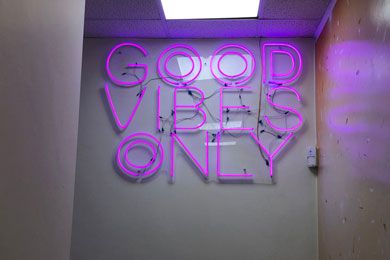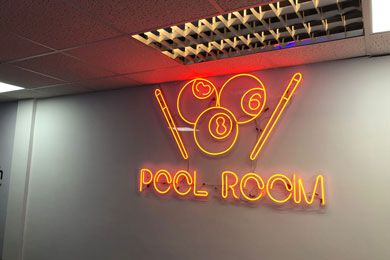LED vs Neon Signage: Which Is Right for Your Business?
When it comes to selecting the right signage for your business, two popular options often stand out: LED signs and neon signs. Both have their unique characteristics and aesthetic appeal, but the question remains—which one is the right choice for your business? In this blog, we'll explore the key differences between LED and neon signage, helping you make an informed decision based on your needs, budget, and branding goals.
Which to choose: If you're looking for a classic, artistic look, neon might suit your brand. However, if maximum visibility and bold colors are important, LED is likely a better fit.
Moreover, the cost of installation and maintenance for LED signs tends to be lower. LEDs have a longer lifespan and are less prone to breaking. Neon signs, made of delicate glass tubes filled with gas, are more fragile and require regular maintenance, which can add to your expenses over time.
Which to choose: If budget and energy efficiency are high priorities, LED signs offer a cost-effective and sustainable solution. If you’re more focused on artistic appeal and are willing to accommodate the higher energy use, neon may be your choice.
On the flip side, neon signs are more delicate. The glass tubes can break easily, and they are susceptible to damage in extreme weather conditions. While neon signs can still be used outdoors, they generally require more care and maintenance to ensure they remain in good condition.
Which to choose: For businesses located in areas prone to extreme weather or those looking for a more low-maintenance option, LED is the better choice. Neon may work well for indoor spaces or businesses willing to invest in regular upkeep.
While neon signs can be shaped into various designs, their options are somewhat limited due to the nature of the glass tubes. Neon signs usually come in a more restricted color palette and don’t have the same versatility in terms of animation or dynamic effects.
Which to choose: If you’re looking for intricate designs, logos, or dynamic effects in your signage, LED is the way to go. Neon works better for simple, straightforward designs that focus on artistic appeal.
Neon signs, by contrast, contain gases like argon and mercury, which can pose environmental risks if not disposed of properly. This makes LED the more eco-conscious option for businesses looking to reduce their carbon footprint.
Which to choose: If environmental responsibility is a core value of your business, LED signage aligns better with those goals.
At Signs Lab, we specialize in helping businesses choose the right signage solutions to enhance their brand presence. Whether you're leaning toward LED signs or neon signs, our team of experts is here to guide you through every step of the process, ensuring your signage reflects your business identity and meets your operational needs.
Aesthetics and Visibility
Neon signs have a nostalgic charm that evokes a vintage feel, often associated with classic diner-style signage and retro aesthetics. The warm glow of neon can create a welcoming ambiance and is often chosen for businesses that want to capture a unique, artistic vibe. On the other hand, LED signs offer sharper and more vibrant colors, making them more visible from a distance. Their brightness makes them ideal for businesses that need to grab attention, especially in areas with high traffic or where visibility is key during both day and night.Which to choose: If you're looking for a classic, artistic look, neon might suit your brand. However, if maximum visibility and bold colors are important, LED is likely a better fit.
Energy Efficiency and Cost
When comparing the two in terms of energy consumption, LED signage takes the lead. LED signs are highly energy-efficient, using up to 75% less energy than neon signs. This translates into significant savings on electricity bills, especially for businesses that plan to keep their signage illuminated 24/7. In contrast, neon signs are less energy-efficient, consuming more power to maintain their distinctive glow.Moreover, the cost of installation and maintenance for LED signs tends to be lower. LEDs have a longer lifespan and are less prone to breaking. Neon signs, made of delicate glass tubes filled with gas, are more fragile and require regular maintenance, which can add to your expenses over time.
Which to choose: If budget and energy efficiency are high priorities, LED signs offer a cost-effective and sustainable solution. If you’re more focused on artistic appeal and are willing to accommodate the higher energy use, neon may be your choice.
Durability and Maintenance
Durability is another key factor in the LED vs. neon debate. LED signs are made from sturdy materials and are resistant to harsh weather conditions, making them ideal for both interior and exterior signage. They can withstand exposure to rain, wind, and UV rays without deteriorating, ensuring longevity.On the flip side, neon signs are more delicate. The glass tubes can break easily, and they are susceptible to damage in extreme weather conditions. While neon signs can still be used outdoors, they generally require more care and maintenance to ensure they remain in good condition.
Which to choose: For businesses located in areas prone to extreme weather or those looking for a more low-maintenance option, LED is the better choice. Neon may work well for indoor spaces or businesses willing to invest in regular upkeep.
Flexibility in Design
LED signs offer greater design flexibility compared to neon signs. With LED technology, businesses can opt for a wide range of shapes, fonts, and colors. They can also incorporate dynamic features like flashing lights, animations, and color-changing effects, making the signage highly customizable.While neon signs can be shaped into various designs, their options are somewhat limited due to the nature of the glass tubes. Neon signs usually come in a more restricted color palette and don’t have the same versatility in terms of animation or dynamic effects.
Which to choose: If you’re looking for intricate designs, logos, or dynamic effects in your signage, LED is the way to go. Neon works better for simple, straightforward designs that focus on artistic appeal.
Environmental Impact
In today’s business landscape, sustainability matters. LED signs are considered more environmentally friendly because of their energy efficiency and long lifespan. LEDs use fewer natural resources and produce fewer emissions compared to neon signage.Neon signs, by contrast, contain gases like argon and mercury, which can pose environmental risks if not disposed of properly. This makes LED the more eco-conscious option for businesses looking to reduce their carbon footprint.
Which to choose: If environmental responsibility is a core value of your business, LED signage aligns better with those goals.
Which Is Right for Your Business?
Ultimately, the decision between LED and neon signage comes down to your business’s unique needs. If you value cost efficiency, durability, and design flexibility, LED signs are likely the best option. On the other hand, if you want to evoke a classic, artistic aesthetic and are less concerned with energy usage or maintenance, neon signs could be the right fit.At Signs Lab, we specialize in helping businesses choose the right signage solutions to enhance their brand presence. Whether you're leaning toward LED signs or neon signs, our team of experts is here to guide you through every step of the process, ensuring your signage reflects your business identity and meets your operational needs.




